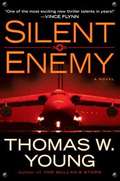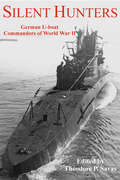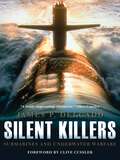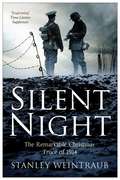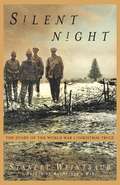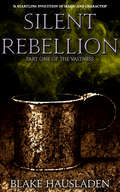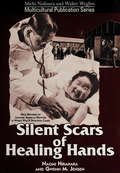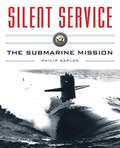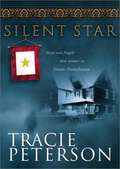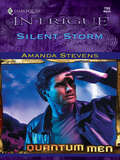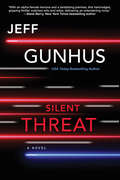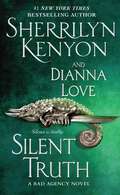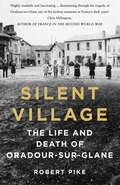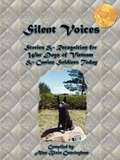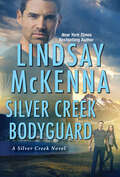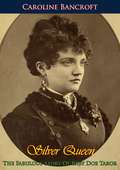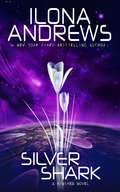- Table View
- List View
Silent Descent
by Dick CouchA U.S. spy has gone missing. A Navy Seal team is sent to bring him back.
Silent Enemy
by Tom YoungEstimated time of arrival: Never...When a terrorist bombing strikes a police training center in Kabul, Afghanistan, many are killed. The wounded, including Sergeant Major Sophia Gold, are loaded onto a C-5 Galaxy bound for Germany. But after takeoff, aircraft commander Michael Parson receives a message: the jihadists have placed bombs on planes leaving Afghanistan--and his is one of them. They are trapped in the air. And if they descend, they will die.As the aircraft deteriorates and the patients grow worse, Parson, Gold, and the crew are pushed to the breaking point--and their biggest challenge has yet to show itself.For the enemy is already closer than any of them can dare to imagine...
Silent Hunters: German U-boat Commanders of World War II
by Theodore P. SavasWhen World War II erupted across Europe in 1939, Germany knew it could not hope to compete with the Royal Navy in a head-to-head naval war. Left with no viable alternatives, the U-Bootwaffe wagered everything on the submarine in a desperate attempt to sink more tonnage than the Allies could construct. Some of these “silent hunters” who slipped out of their shelters along Europe's shores to stalk their prey have enjoyed considerable recognition in the years since. While most aspects of the bitter struggle have been told and retold from both the Axis and Allied points of view, the careers of some highly effective U-boat commanders have languished in undeserved obscurity. The profiles of six such commanders are presented in this collection of essays. They include Englebert Endrass, whose spectacular career before being lost off the coast of Gibraltar is described here by his best friend and fellow ace Enrich Topp, who wrote this while on his 15th War Patrol; Karl-Friedrich Merten, who was ranked among the war's top tonnage aces; Ralph Kapitsky, whose U-615 suicidal surface-to-air battle in the Caribbean allowed many of his fellow submariners to escape into the Atlantic; Fritz Guggenberger, who sank an aircraft carrier and organized the biggest POW escape attempt in American history; Victor Oehrn, a former staff officer of Karl Dönitz's; and Heinz Eck, who was executed by the British.
Silent Killer: Grant’s Logistical Requirements
by Lt-Col Philip M. MattoxThis monograph examines Grant's campaign of 1864-1865 from a logistics perspective. It answers the following questions: 1. Did logistical systems change for the emerging operational level of war? 2. Did Civil War field logistics form today's concepts at the operational level? 3. Were logistics planning factors derived from Napoleon? It concludes with a discussion of how Grant's systems impacted on 1992 logistics systems. The monograph examines the history and formulation of operational requirements for the logistician. Discussed in detail is the necessity for theater base support, visibility and distribution, and the requirement for logistical planning factors. The conclusion is that each of these elements allows the commander to phase his operations, reduce risks and complete a campaign without creating operational pauses or logistical culmination. Finally, the paper compares 1864 principles with principles utilized during Desert Shield/Desert Storm.
Silent Killers: Submarines and Underwater Warfare
by James DelgadoJames P Delgado, President and CEO of the Institute of Nautical Archaeology and author of Nuclear Dawn (Osprey), presents a detailed, stunningly visual, examination of the history and development of the submarine and its role in naval warfare, from the first practical experiments with submersible craft to the development of the modern nuclear submarine. Calling on his training as a nautical archaeologist who was among the first explorers to dive the Titanic, Delgado recreates the story of the sub from the bottom up--that is, through eerie photographs of subs at the bottom of the sea. In addition, he explores submarine technology, from wooden to iron to steel hulls, from hand-cranked to nuclear powered propulsion, from candle light to electricity, from gunpowder "torpedoes" to nuclear missiles Since the time of Jules Verne, submarines have been a topic of great interest to maritime and military fans and Delgado's new book explores all of the submarine's triumphs and tragedies, successes and failures in this fascinating and compelling illustrated history.
Silent Night
by Stanley WeintraubSILENT NIGHT brings to life one of the most unlikely and touching events in the annals of war. In the early months of WWI, on Christmas Eve, men on both sides left their trenches, laid down their arms, and joined in a spontaneous celebration with their new friends, the enemy. For a brief, blissful time, remembered since in song and story, a world war stopped. Even the participants found what they were doing incredible. Germans placed candle-lit Christmas trees on trench parapets and warring soldiers sang carols. In the spirit of the season they ventured out beyond their barbed wire to meet in No Man's Land, where they buried the dead in moving ceremonies, exchanged gifts, ate and drank together, and joyously played football, often with improvised balls. The truce spread as men defied orders and fired harmlessly into the air. But, reluctantly, they were forced to re-start history's most bloody war. SILENT NIGHT vividly recovers a dreamlike event, one of the most extraordinary of Christmas stories.
Silent Night: The Story of the World War I Christmas Truce
by Stanley WeintraubIt was one of history's most powerful -- yet forgotten -- Christmas stories. It took place in the improbable setting of the mud, cold rain and senseless killing of the trenches of World War I. It happened in spite of orders to the contrary by superiors; it happened in spite of language barriers. And it still stands as the only time in history that peace spontaneously arose from the lower ranks in a major conflict, bubbling up to the officers and temporarily turning sworn enemies into friends. Silent Night, by renowned military historian Stanley Weintraub, magically restores the 1914 Christmas Truce to history. It had been lost in the tide of horror that filled the battlefields of Europe for months and years afterward. Yet in December 1914 the Great War was still young, and the men who suddenly threw down their arms and came together across the front lines -- to sing carols, exchange gifts and letters, eat and drink and even play friendly games of soccer -- naively hoped that the war would be short-lived, and that they were fraternizing with future friends. It began when German soldiers lit candles on small Christmas trees, and British, French, Belgian and German troops serenaded each other on Christmas Eve. Soon they were gathering and burying the dead, in an age-old custom of truces. But as the power of Christmas grew among them, they broke bread, exchanged addresses and letters and expressed deep admiration for one another. When angry superiors ordered them to recommence the shooting, many men aimed harmlessly high overhead. Sometimes the greatest beauty emerges from deep tragedy. Surely the forgotten Christmas Truce was one of history's most beautiful moments, made all the more beautiful in light of the carnage that followed it. Stanley Weintraub's moving re-creation demonstrates that peace can be more fragile than war, but also that ordinary men can bond with one another despite all efforts of politicians and generals to the contrary.
Silent Rebellion (The Vastness #1)
by Blake HausladenThis novella is part one of The Vastness, also available as a collection.Emilia, a girl who lives inside her head with numbers as a slave to a city that consumes all those like her. Emi quickly becomes the center of a vast rebellion as a magic grows inside her, unparallel to anything known.“The main character is very complex and the story is full and complete for a novella. I hope to see Emilia in future novels to learn more about her. I highly recommend all three books by this very detailed and complex author.” – Amazon ReviewThe Vastness is the third and final omnibus collection to the Vesteal Series. The Vastness takes us deep into the capital of Bessradi, following the chaos of Native Silver, where new magic is emerging. Ghosts stir, the ground shakes, and an unknown magic has been unleashed. Blood soon becomes as important as air, and our characters struggle to keep the world balanced.In the end, the war will be over, but which side will win?“I tried to hold his threads together, but I could not touch them. His being came apart, and I was splashed with a sick wash of darkness.” - EmiYou can read the trilogy in full volumes, or broken up into five novellas each.The Vestal SeriesA tale of violent magic, intrigue, and statecraft, the Vesteal Series is the story of four souls that are banished beyond the edge of the map to a land of gnarled forests, ancient magic, and the site of a terrible murder. Their struggles to survive will put them at odds with their families, their nation, and the very powers that shaped the world.1. Ghosts in the Yew Novella 1 - Beyond the Edge Novella 2 - Opposing Oaths Novella 3 - Reckless Borders Novella 4 - Bayen's Women Novella 5 - Falling Tides2. Native Silver Novella 1 - Sutler's Road Novella 2 - Forgotten Stairs Novella 3 - Thrall's Wine Novella 4 - Corsair Princess Novella 5 - Tanayon Born 3. The Vastness Novella 1 - Silent Rebellion Novella 2 - The River War Novella 3 - The Blinded Novella 4 - Crimson Valley Novella 5 - Singer's Reward
Silent Scars of Healing Hands: Oral Histories of Japanese American Doctors in World War II Detention Camps (Michi Nishiura and Walter Weglyn Multicultural Publication Series)
by Naomi Hirahara Gwenn JensenOn February 19, 1942, by order of President Franklin D. Roosevelt, all Nikkei (American born Japanese American citizens) were subject to an indiscriminate and mass incarceration that affected more than 110,000 people. Within weeks, Issei and Nisei doctors found themselves vaccinating long lines of people in anticipation of their imminent removal from homes and businesses. Cast into temporary detention, these same physicians struggled to open clinics and treat patients in facilities ill prepared for the onslaught of families, pregnant, women, elderly, and toddlers. This book is their story -- a collection of oral histories of Nisei physicians who directed health care behind barbed wires.
Silent Service: Submarine Warfare from World War II to the Present?An Illustrated and Oral History
by Philip KaplanSee the secret and dangerous world of submarine life and warfare like never before. From the ingenious but impractical designs of seventeenth-century inventors through the nuclear-powered submarines of today, this heavily illustrated volume traces the history of the silent force and the elite corps of men who fought and often died beneath the waves. Though fully describing the development of the submarine, this book’s main focus is on the men who served from World War I through the Cold War. Drawing upon journals, memoirs, and interviews with submariners of the past and present, Philip Kaplan paints a vivid portrait of their lives and experiences. He describes the terrors of waiting for depth charges to explode and the triumph of a torpedo striking its target, as well as the fascinating world of day-to-day life on the sleek, modern boats. With nearly 250 photographs and dozens of interviews--and comprising part of an eight-book series exploring the history of tanks, bombers, and fighter planes--this oversized keepsake volume will appeal to anyone who has served in submarines or been fascinated by this unique service within a service. Skyhorse Publishing, as well as our Arcade imprint, are proud to publish a broad range of books for readers interested in history--books about World War II, the Third Reich, Hitler and his henchmen, the JFK assassination, conspiracies, the American Civil War, the American Revolution, gladiators, Vikings, ancient Rome, medieval times, the old West, and much more. While not every title we publish becomes a New York Times bestseller or a national bestseller, we are committed to books on subjects that are sometimes overlooked and to authors whose work might not otherwise find a home.
Silent Star
by Tracie PetersonPeople in pain often do not understand the wounds they give others ... So go the words of Estella, whose years have given her a wisdom she longs to share. But her insights give little reassurance to Andy, whose torment seems to obliterate any chance he has for happiness. With each day that passes, his responsibilities with the telegram office have become a far heavier burden than the mailbag he carries. But over time this unlikely pair may be able to bring a tender gift to a town lost in its own sorrows.
Silent Storm (Quantum Men Ser. #2)
by Amanda StevensHE WAS THE MOST EXTRAORDINARY MALEThe kind a small-town girl like Marly Jessop had rarely—if ever—seen in the flesh. Deacon Cage arrived in Mission Creek, Texas, like a specter in the night, stealthy and secretive. And his ability to stir Marly’s feminine senses was like no other man’s….But she didn’t have time for female fantasies. As local deputy, Marly had her hands full with a rash of suspicious suicides. Could there be a link between them and the killer Deacon came to catch? And would Marly survive her run-in with the desirable Deacon?
Silent Threat
by Jeff Gunhus&“Super-high stakes, super-high concept, and super-charged action. This propulsive spy thriller changes all the rules—it will have you holding your breath until you discover the final shocking truth. Jeff Gunhus is a terrific talent.&” —Hank Phillippi Ryan, national bestselling author of The Murder List A father charged with treason. A daughter sent to kill him. A shocking conspiracy that changes all the rules of the spy game for a new generation . . . With more than a dozen kills under her belt, ex-Marine Mara Roberts is one of the Agency&’s most reliable assassins. But her latest target—a convicted traitor about to be released from prison—is different than her other marks. He&’s a former agent who betrayed his country. He&’s responsible for the death of Mara&’s mother. And he happens to be Mara&’s father . . . Scott Roberts knows that his daughter was sent to kill him. He realizes he has only one chance to change her mind, to convince her that he&’s been framed for treason—and that every member of their family are pawns to be sacrificed, one by one. Mara isn&’t sure she can trust her father. He is a master of manipulation, as ruthless as he is resourceful. But when her nephew is abducted, she agrees to follow Scott&’s lead and expose the global elites who are pulling the strings. But first, they must infiltrate the highest levels of power. Then, they must attempt the unthinkable: Kidnap the President of the United States . . . &“A brilliantly written thriller. Breakneck twists, political intrigue and bristling action scenes—Jeff Gunhus writes with a gripping and gritty authority.&”—Simon Gervais, author of Hunt Them Down
Silent Threat (Executioner #380)
by Don Pendleton Phil ElmoreWhen several German CEOs become victims in deadly accidents and their strategic companies are suddenly bought out, red flags are raised in US intelligence circles. All signs indicate that the buyouts are being orchestrated by the head of a powerful cult and he's planning a terrorist attack. But getting to the cult leader and ending the threat proves to be challenging--especially when an army of zealous followers bristling with weapons are prepared to die for the cause. Mack Bolan is determined to infiltrate the group and destroy the organization before they unleash their plan of destruction. The cult leader may believe he can bring death, but there is only one Executioner.
Silent Truth (B.A.D. Agency #Bk. 4)
by Sherrilyn Kenyon Dianna LoveIn the sizzling new adventure from New York Times bestselling authors Sherrilyn Kenyon and Dianna Love, a red-hot BAD boy teams up with a sexy television reporter on an explosive quest for revenge. Tough-as-nails Bureau of American Defense agent Hunter Thornton-Payne is no stranger to uncomfortable top-secret missions, but tonight takes the cake. He just needs to stick out a stuffy charity fund-raiser long enough to find the ruthless assassin he’s hunted for four years. It’s a rogue operation, but Hunter’s got nothing to lose—until a beautiful brunette unexpectedly pulls him into her own dangerous agenda. Abbie Blanton will do anything to cure her mother’s mysterious illness. When a high-profile heiress is murdered as Abbie tries to blackmail her for clues, Abbie realizes she’s stumbled into an unforgiving conspiracy—and she’s the next target. Soon, she and Hunter discover an alarming connection and begin a treacherous battle against an evil enterprise that someone will go to terrifying lengths to keep hidden.
Silent Village: Life and Death in Occupied France
by Robert Pike'Based on eye-witness accounts, Robert Pike’s moving book vividly depicts the lives of the villagers who were caught up in the tragedy of Oradour-sur-Glane and brings their experiences to our attention for the first time.' - Hanna Diamond, author of Fleeing HitlerOn 10 June 1944, four days after Allied forces landed in Normandy, the picturesque village of Oradour-sur-Glane in the rural heart of France was destroyed by an armoured SS Panzer division. Six hundred and forty-three men, women and children were murdered in the nation’s worst wartime atrocity. Today, Oradour is remembered as a ‘martyred village’ and its ruins preserved, but the stories of its inhabitants lie buried under the rubble of the intervening decades. Silent Village gathers the powerful testimonies of survivors in the first account of Oradour as it was both before the tragedy and in its aftermath. Why this peaceful community was chosen for extermination has remained a mystery. Putting aside contemporary hearsay, Nazi rhetoric and revisionist theories, Robert Pike returns to the archival evidence to narrate the tragedy as it truly happened – and give voice to the anguish of those left behind.
Silent Voices: Stories and Recognition for War Dogs of Vietnam and Canine Soldiers Today
by Alan Blain CunninghamStories and drawings of valiant war dogs. This compilation of pieces mainly follows the author's attempts to get a commemorative postage stamp for military war dogs and a memorial. [Poorly edited, errors left in place due to copyright laws.]
Silent Warrior: The Marine Sniper's Vietnam Story Continues
by Charles HendersonIn the United States Marine Corps, the most dangerous job in combat is that of the sniper. With no backup and little communication with the outside world, these men disappeared for weeks on end in the wilderness with nothing but intellect and iron will to protect them--as they would watch, wait, and finally strike. <P><P> But of all of the snipers who ever hunted human prey, one man stands above and beyond as one of the most legendary fighting men ever to pull a trigger... <P> That man was Carlos Hathcock. <P> In Marine Sniper, the true-life missions of United States Marine Corps sniper Carlos Hathcock were revealed in explosive detail. Now, the incredible story of a remarkable Marine continues--with harrowing, never-before-published accounts of courage and perseverance. These are the powerful stories of a man who rose to greatness not for personal gain or glory, but for duty and honor. A rare inside look at the U.S. Marine's most challenging missions--and the one man who made military history.
Silent Warriors, Incredible Courage: The Declassified Stories of Cold War Reconnaissance Flights and the Men Who Flew Them
by Colonel Wolfgang W. SamuelThe outbreak of the Korean War in June 1950 took the American military by surprise. Rushing to respond, the US and its allies developed a selective overflight program to gather intelligence. Silent Warriors, Incredible Courage is a history of the Cold War overflights of the Soviet Union, its allies, and the People's Republic of China, based on extensive interviews with dozens of pilots who flew these dangerous missions. In 1954 the number of flights expanded, and the highly classified SENSINT program was born. Soon, American RB-45C, RB-47E/H, RF-100s, and various versions of the RB-57 were in the air on an almost constant basis, providing the president and military leadership with hard facts about enemy capabilities and intentions. Eventually the SENSINT program was replaced by the high-flying U-2 spy plane. The U-2 overflights removed the mysteries of Soviet military power. These flights remained active until 1960 when a U-2 was shot down by Russian missiles, leading to the end of the program. Shortly thereafter planes were replaced by spy satellites. The overflights were so highly classified that no one, planner or participant, was allowed to talk about them—and no one did, until the overflight program and its pictorial record was declassified in the 1990s. Through extensive research of existing literature on the overflights and interviews conducted by Wolfgang W. E. Samuel, this book reveals the story of the entire overflight program through the eyes of the pilots and crew who flew the planes. Samuel's account tells the stories of American heroes who risked their lives—and sometimes lost them—to protect their country.
Silent and Unseen
by Alfred Scott MclarenIn Silent and Unseen, veteran submarine commander Captain Alfred S. McLaren describes in riveting detail the more significant events that occurred early in the Cold War during his seven years, 1958-1965, onboard three attack submarines: the USS Greenfish (SS-351), USS Seadragon (SSN-584), and USS Skipjack (SSN-585). Through myriad stories and anecdotes, his book focuses on the development of attack-boat tactics and under-ice exploration techniques. The commanding officers that a young submarine officer serves with will determine how well prepared he will be to assume his own command years later. This was particularly true in attack submarines, during the early high-risk years of the Cold War. They were continually at sea, and each reconnaissance and intelligence collection mission was of potentially great, and sometimes extraordinary, value to the government of the United States of America. The missions more often than not required closing of the potential enemy to collect the intelligence desired, generally within weapons range. But, unlike a war patrol, the U. S. attack boat had to remain completely undetected; then withdraw as silently and unseen as it approached. Greenfish was one of the most successful Pacific diesel submarines when McLaren served aboard her as a watch and weapons officer during an era when she and other diesel boats executed all Cold War missions and overseas deployments. McLaren then reported to Seadragon in time to serve as a watch officer, as she became the first nuclear submarine to transit from the Atlantic to the Pacific via the Arctic Ocean. En route, she examined the underside of icebergs, conducted the first underwater survey and passage through the Northwest Passage, and surfaced at the North Pole. He subsequently served as diving officer, an engineering department division officer and as weapons officer during a series of Cold War missions and a lengthy Western Pacific deployment. Silent and Unseen concludes with a recounting of the author’s experiences as diving officer, navigator, and chief engineer onboard what was then world’s fastest and most advanced submarine, USS Skipjack (SSN-585) during the Cuban Missile Crisis, two Cold War missions, and the very intensive and exciting period of new tactical and weapons development which followed to counter a rapidly emerging Soviet nuclear submarine threat
Silver Creek Bodyguard (Silver Creek #4)
by Lindsay McKennaNew York Times bestselling author Lindsay McKenna returns to Silver Creek, Wyoming, where a veteran SEALwho is now one of a security team&’s finest, is assigned to guard a beautiful woman haunted by her family&’s dangerous past. . . . With a fresh start in the heart of big sky country, Sara Romano is thrilled to bring her herbal remedies to the lovely people of Silver Creek, Wyoming. But when her dark past follows her, and Sara is nearly killed, she knows she is in imminent danger. Reluctantly accepting the bodyguard her mother hires, Sara opens her home to Wes Paxton. Trained to protect, the ruggedly handsome stranger soothes her fears, making Sara feel cared for in a way she has not felt in a long time. If only she had the courage to tell him her family&’s secrets. . . . A former orphan who found family in the military, Wes can&’t ignore the feeling that Sara is holding back. The more time he spends with her, the more he understands how afraid she is—which only sends his well-honed protective instincts into overdrive. So when danger finally closes in, Wes is an army of one, ready to do anything to protect the woman he&’s falling hard for . . .&“Lovers of action-packed romantic suspense will delight in this intense tale.&”—Publishers Weekly on Wind River Undercover
Silver Days
by Sonia LevitinIn this sequel to "Journey to America", the reunited Piatt family works hard at settling in to America, but the specter of the war in Europe continues to affect their lives.
Silver Queen: The Fabulous Story Of Baby Doe Tabor (The\bancroft Booklets Ser.)
by Caroline BancroftThis is a fascinating autobiography of Baby Doe Tabor, the second wife of pioneer Colorado businessman Horace Tabor, whose rags-to-riches and back to rags again story made her a well-known figure in her own day, and at one time hailed as the "best dressed woman in the West."It was during Baby Doe's final years of her life living in a shack on the site of the Matchless Mine, enduring great poverty, solitude, and repentance, that fellow Coloradan Caroline Bancroft met Baby Doe, who had known Bancroft's father for many years, and became fascinated by her "smile, the manner, the voice and the flowery speech [...] despite her diminutive size."Following Tabor's death in the Matchless Mine cabin on March 7, 1935, Bancroft was commissioned to write her biography, her greatest source of information provided by Sue Bonnie, who had discovered Tabor's body. This book, originally published in 1955, is the result: "Baby Doe Tabor tells us of her life in nearly her own words--many she actually used in talking to Sue Bonnie and others I have imagined as consonant with her character and the facts of her story."
Silver Shark (The World of Kinsmen #2)
by Ilona AndrewsThe World of KinsmenFamily is everything. Talent is power. And revenge is sweet.In a distant, future world Kinsmen—small powerful groups of genetically and technologically advanced families—control vast financial empires. They are their own country, their own rulers, and their only limits are other Kinsmen. The struggle for power is a bloody, full-contact sport: in business, on the battlefield...and sometimes in the bedroom. Claire Shannon is a killer…and her weapon is her mind.Born on a planet torn by war for over 300 years, Claire is a soldier: a psycher, with the ability to read, control, and destroy the minds of enemy psychers and to infiltrate the biological network where they battle to death.When Claire’s faction loses the war, she barely escapes extermination from both sides, as her talent brands her as too dangerous to society. By so-deeply burying her ability that she avoids detection, Claire is instead deported to Rada as a refugee, where she must find work to remain. She finds a job as personal assistant to Venturo Escana, a premiere kinsman; one of Rada’s most wealthy entrepreneurs—and most powerful psychers.She thought she had left war behind, but now she must hide her skills and her growing feelings from Venturo…and this battle might just cost her everything…
Silver Stallion: A Novel of Korea
by Ahn JunghyoIn a mountain village in Korea, 1950, the memory of the Japanese occupation has just begun to fade when the farmers hear that the World Army, led by the great American General "Megado", has landed at Inchon. Copyright © Libri GmbH. All rights reserved.

